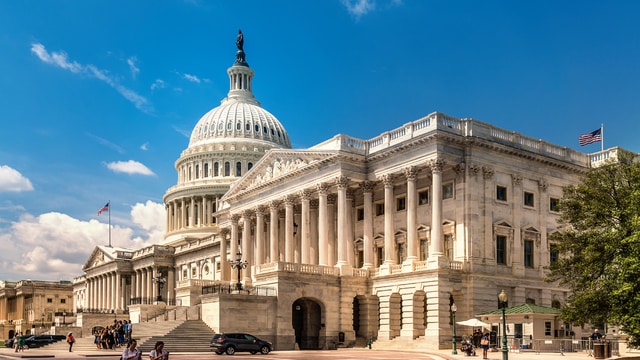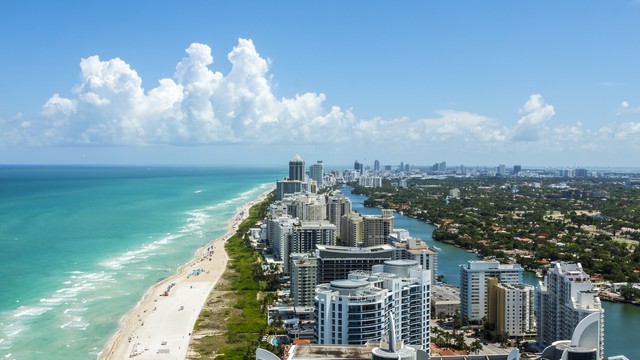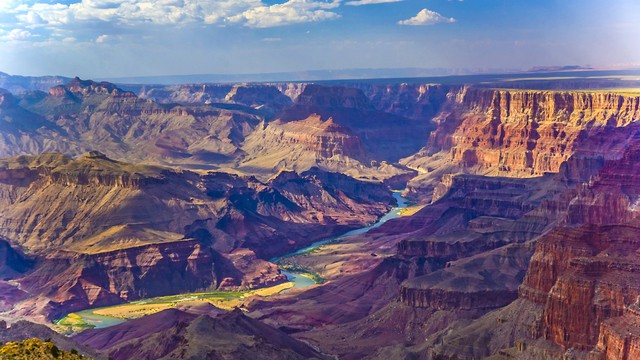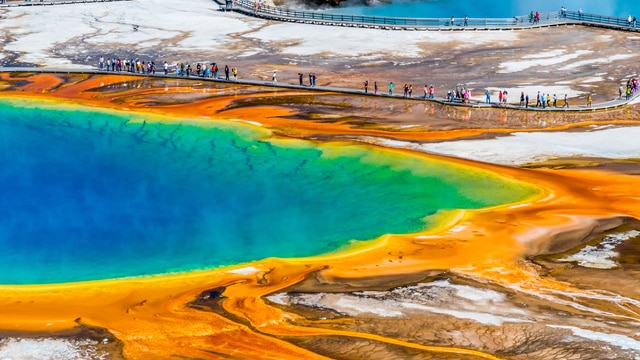What’s the climate like in Washington D.C.?
The current climate of Washington D.C. features average monthly temperatures ranging from highs of 33°C during the day to lows of 7°C. The average yearly temperature is around 21°C. At night, temperatures in the colder months average around -1°C and in the warmer months around 22°C.
The highest temperature recorded in Washington D.C. in recent years was 42°C in August 2023. The lowest daytime temperature recorded was -10°C in December 2016.
On average, Washington D.C. gets 992 mm of precipitation each year. Of this, about 19 cm is snowfall. For comparison, London gets 701 mm of precipitation each year.
Curious about the climate in other parts of United States? Check out the weather and climate in places like New York City, Miami, Los Angeles, or have a look at other destinations in United States.
Best time to visit Washington D.C.?
The best time to visit Washington D.C. for sunny weather is April through October. During this period, you'll have good temperatures and not too much rain, making it a great time to visit Washington D.C.. In the other months of the year, there's too much rain or the temperature isn't ideal for a visit if you want sunny and pleasant weather.
Climate Table of Washington D.C.
The climate table of Washington D.C. shows the average temperatures, precipitation, snow, and UV index per month. The table gives an overview of the average day and night temperatures in degrees Celsius, the total amount of precipitation in millimetres, the total snowfall in centimetres, and the UV index for each month. Precipitation is always measured as water, even if it's snow or hail.
| Jan | Feb | Mar | Apr | May | Jun | Jul | Aug | Sep | Oct | Nov | Dec | |
|---|---|---|---|---|---|---|---|---|---|---|---|---|
| Temp. max (°C) | 7 | 9 | 15 | 20 | 26 | 31 | 33 | 32 | 28 | 22 | 16 | 11 |
| Temp. min (°C) | -1 | 1 | 4 | 9 | 15 | 20 | 22 | 22 | 18 | 11 | 5 | 1 |
| Precipitation | ||||||||||||
| Precipitation (mm) | 65 | 97 | 55 | 87 | 117 | 84 | 88 | 116 | 59 | 92 | 69 | 63 |
| Snow (cm) | 7,3 | 7,3 | 2,7 | 0,1 | 0 | 0 | 0 | 0 | 0 | 0 | 0,1 | 0,6 |
| UV Index | 2 | 5 | 4 | 6 | 5 | 7 | 4 | 6 | 4 | 4 | 3 | 2 |
Click on the month name to see more weather details, like daily averages, temperatures, and precipitation for the past years in that month.
- Average yearly temperature: 21°C
- Highest temperature: 33°C in July
- Lowest temperature: 7°C in January
- Precipitation*: 992 mm per year, averaging 83 mm per month
- Snowfall: 19 cm per year
- Driest months: 55 mm in March, 59 mm in September and 63 mm in December
- Wettest months: 117 mm in May, 116 mm in August and 97 mm in February
*Precipitation is measured as a combination of rain, snow, and hail
Weather experiences in Washington D.C.
Average Temperature per Month in Washington D.C.
This graph shows the average maximum temperatures per month in Washington D.C., United States. The temperatures are shown in degrees Celsius and the average is calculated based on the recorded temperatures per month from past years.
Average Precipitation per Month in Washington D.C.
This graph shows how much precipitation Washington D.C., United States, gets on average per month. Precipitation is always measured as water, even if it's snow or hail. This makes it easy to compare how much has fallen, regardless of the form of precipitation. The amount of precipitation is measured in millimetres and the average is calculated based on the recorded precipitation per month from past years.
Average Snowfall per Month in Washington D.C.
This graph shows how much snow Washington D.C., United States, gets on average per month. The amount of snowfall is measured in centimetres and the average is calculated based on the recorded snowfall per month from past years.
Average UV Index per Month in Washington D.C.
This graph shows the average UV index per month in Washington D.C., United States. The UV index indicates the intensity of ultraviolet radiation and ranges from 0 to a maximum of 11.
Yearly Temperature in Washington D.C.
This graph shows the average yearly temperature in Washington D.C., United States. The yearly temperature, expressed in degrees Celsius, is the average of all twelve monthly temperatures summed up for that year.
Total Yearly Precipitation in Washington D.C.
This chart shows the total yearly precipitation in Washington D.C., United States, over the past few years. The total yearly precipitation, measured in millimetres, is the sum of all the rain that fell in the twelve months of that year.
Total Yearly Snowfall in Washington D.C.
This chart shows the total yearly snowfall in Washington D.C., United States, over the past few years. The total yearly snowfall, measured in centimetres, is the sum of all the snow that fell in the twelve months of that year.
Weather experiences in Washington D.C.
The weather in Washington D.C. is rated an average of 3,2 out of 5 stars by 11 visitors. Have you been to Washington D.C.? Share your weather experience to help other visitors.
Write your own reviewWashington, DC April offered a pleasant combination of mild temperatures and clear skies. Although the frequent rains were annoying, the spring blooms were breathtaking. An umbrella is definitely recommended!— This text is automatically translated to English
Washington weather in January is cold and can be unstable, with lots of snow and icy winds. Although it can be a winter wonderland, the cold temperatures are not ideal for outdoor activities.— This text is automatically translated to English
there was much to be desired. Cold temperatures, around 0 degrees and lots of rain. The sun was nowhere to be seen and there was no snow to decorate the city. Not an ideal time to visit.— This text is automatically translated to English
It was pretty cold and grey in Washington in February. There was some snow, but not enough for winter sports. There was also no opportunity for swimming, only visits to museums.— This text is automatically translated to English
Washington DC had pleasant sunshine and a mild climate in September. However, there were rainy days too. Bring umbrellas in case of unexpected rain!— This text is automatically translated to English
June was warm and sunny in Washington, perfect for exploring the city. At times, however, it was too hot and humid. In my opinion, the weather is worth 4 out of 5 stars.— This text is automatically translated to English
The weather in Washington in May was generally good, with bright, sunny days, ideal for sightseeing. There were several showers and fairly high humidity, but that did not detract from the experience.— This text is automatically translated to English
The weather in Washington in March was mixed. Cold morning but warm day. Some rain, but also some sunshine. Good for sightseeing, but not beach weather.— This text is automatically translated to English
October weather in Washington, D.C. was mild and pleasant with just the right mix of sunny days and crisp autumn temperatures. Sometimes it rained a little, but not enough to ruin the festive mood!— This text is automatically translated to English
It was cool, cloudy and rainy. The foliage offered beautiful views, but neither sun nor snow distracted us.— This text is automatically translated to English
Washington, D.C., was hot and humid in August, with temperatures often exceeding 30 degrees. Although it was nice and sunny, the high humidity sometimes made it uncomfortable. Get ready for hot days!— This text is automatically translated to English
Have you been to Washington D.C.?
Share your weather experiences in Washington D.C..
Average Weather in Washington D.C. by Month
Click on a month below to see detailed weather info for Washington D.C.. Based on historical weather data, you can see the average temperature, precipitation, wind, and UV index for each day of the month.
Popular destinations in United States
Discover the climate of these popular destinations in United States.












